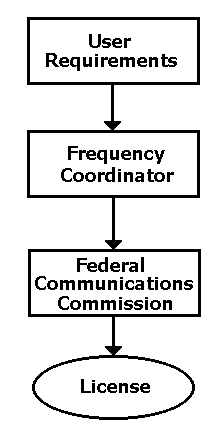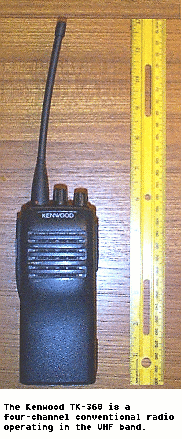The lifeblood of any trunked radio system is clear and reliable access to enough frequencies to support the mission of the system owner. Getting and keeping those radio frequency assignments for public safety use often involves several public and private organizations. This month we'll take a look at the process for assigning frequencies to public safety users and hopefully provide some relevant information for those of you writing letters to your local governments about proposed radio systems.
In the United States, the Federal Communications Commission (FCC) controls radio frequency assignments for non-Government use. Historically the FCC has divided up the available frequencies into different groups and assigned them to a specific use. For instance, a large set of frequencies in the VHF (Very High Frequency) and UHF (Ultra High Frequency) ranges are assigned to over-the-air television broadcasters. Cellular telephone and PCS service providers have their own set of frequencies in the 800 MHz (megahertz) and 1.9 GHz (gigahertz) range.
Public Safety Radio Pool
The FCC has reserved several blocks of frequencies for exclusive use by public safety agencies. While we often think of these agencies as police, fire and emergency medical services, under current FCC rules a wide variety of organizations and individuals qualify to use these frequencies. By showing that they provide some type of public safety mission, whether through a letter from a government official or operation as a non-profit organization, they can be assigned frequencies from this Public Safety Radio Pool.
Some qualifying organizations and individuals include veterinarians, animal hospitals, persons with disabilities, funeral director associations, disaster relief organizations, blood banks, heart and lung centers, school bus services and boards of education, botanical gardens, departments of agriculture and environmental resources, beach patrols, retirement facilities and homes for the aged, mental health institutions, rehabilitation centers, electric power cooperatives, state reservations and tribal councils, universities, water control boards, and emergency repair services for public communications facilities.
There are five primary bands that make up the Public Safety Radio Pool:
| Low-Band VHF | 30 MHz to 50 MHz | |
| Mid-Band VHF | 72 MHz to 76 MHz | |
| High-Band VHF | 138 MHz to 144 MHz | |
| 148 MHz to 174 MHz | ||
| 220 MHz to 222 MHz | ||
| Low-Band UHF | 406.1 MHz to 420 MHz | |
| 450 MHz to 470 MHz | ||
| 470 MHz to 512 MHz | ||
| 800 MHz Band | 806 MHz to 824 MHz | |
| 851 MHz to 869 MHz |
The 800 MHz band includes the nationwide common-use frequencies specified by the National Public Safety Planning Advisory Committee (NPSPAC):
| Calling | 866.0125 | ITAC-1Mutual Aid #1 | 866.5125 | ITAC-2Mutual Aid #2 | 867.0125 | ITAC-3Mutual Aid #3 | 867.5125 | ITAC-4Mutual Aid #4 | 868.0125 | STAC-5Portable/Mobile | 868.7875 (low power) |
In addition, the 700 MHz band is scheduled to become available in 2006 after the current occupants, UHF television broadcasters, finally vacate the band and move to their new digital TV frequencies. The assignments from 764 MHz to 776 MHz and from 794 MHz to 806 MHz are reserved for public safety use.
Frequency Assignment Process
Let's walk through the process for a fictional place we'll call Middletown. Middletown has been using two frequencies on conventional, low-band VHF radios for the past twenty years or so, and during that time the town has grown from a handful of police officers and a small volunteer fire department to several dozen officers and three fire stations. Surrounding communities have also grown, as has the demand on county services.
The Middletown radio system is overloaded. When the system was first put together during the Carter Administration one frequency was assigned to the police force and the other to the volunteer fire department. Because of the one-department-one-frequency assignment, when one police officer is speaking all the others have to wait. This worked fine for many years, but as the department grew the amount of radio traffic during busy periods eventually outgrew the capacity of the single frequency. And now when there's a fire, the fire department has constant traffic on their frequency and there are significant delays for firefighters trying to get messages to each other.
In addition, after more than twenty years most of the original equipment is obsolete and nearly impossible to maintain or repair.
After approval from the town council, Middletown issued an RFP (Request for Proposal) to several consulting firms with experience in designing public safety radio systems. After a review and selection process, the town contracted with a nearby engineering company.
 System Requirements
System Requirements
The first step in applying for frequencies is to figure out exactly what to ask for. The user needs to define their communications requirements, answering such questions as, which departments and how many users will be on the system? How often will they communicate, and whom do they need to talk to? What kind of geographic coverage do they need? Will other agencies and towns also share the system? Equally important, what kind of budget is available for such a system?
Another choice to be made is whether to operate as a conventional system where users are assigned to a specific frequency or as a trunked system where all of the frequencies are shared among all the users.
Trunking is a better way to go for large systems, since the available frequencies are used more efficiently than in conventional systems. This means that the same number of frequencies can serve more users in a trunked system than in a conventional system. Trunking also provides faster access time and is easier to expand as new users join the system. On the other hand, trunked systems are much more expensive than conventional systems, and they require more training to operate and maintain.
Frequency Coordinator
One the particulars about the system are known, Middletown and the engineering company will put together a request and sent it to an organization known as a frequency coordinator. Their job is to recommend a set of available frequencies that meet the needs of the applicant but don't conflict with other users. The FCC has approved four frequency coordinators for the Public Safety Radio Pool: American Association of State Highway and Transportation Officials (AASHTO), Association of Public Safety Communications Officials International, Inc. (APCO), Forestry Conservation Communications Association (FCCA) and the International Municipal Signal Association (IMSA). Each of these coordinators is responsible for a part of the Public Safety Radio Pool, depending upon the band and the intended use of the frequencies.
In addition, if the system is expected to operate in the 800 MHz band, the NPSPAC must also review and approve the frequency recommendation.
Radio Signal Propagation
One major criterion in the selection of frequencies is the effect it has on range. Each agency has a particular geographic area in which they need solid radio coverage, and the choice of radio frequency will affect how that coverage will be achieved.
In general, with all other things being equal, lower frequency radio signals travel farther than higher frequencies. Higher frequencies are also more affected by the local environment, including natural and manmade obstructions. In order to provide complete coverage, higher frequencies usually require more repeaters and antenna towers. This adds to the cost of the system, since each tower needs equipment, maintenance, permits, fees, and so on. On the other hand, higher frequencies need shorter antennas, so vehicle mounts and portable radio units are much more convenient at higher frequencies.
The selected frequencies should also match the type of environment an agency is expected to work in. An urban area will have a number of tall buildings, a large population base requiring a large number of radio system users, and a lot of mobile activity. In order to achieve a high level of coverage inside buildings, the system may need to incorporate a larger number of repeater sites that cover smaller areas. Frequencies in the 800 MHz band may work well here, especially since trunked systems can more efficiently support such a large number of users. The risk is that planners may neglect to provide for a sufficient number of repeater sites, leading to gaps in coverage -- the so-called "dead zones" that many large cities are currently experiencing with their new 800 MHz systems.
Rural areas will usually have a few areas with small buildings and a large geographic area to cover. There are also fewer users on the system. In these instances it might be a better choice to use lower frequencies on a conventional system, since the lower cost and greater range are a good match for the operating requirements.
Suburban agencies fall somewhere in-between. They typically have smaller buildings and are more geographically dispersed but may have a large number of radio system users.
Inter-coordination
Once a frequency band has been selected, the coordinator chooses appropriate frequencies that are unlikely to interfere with existing systems. In addition, if the chosen frequencies are adjacent to frequencies handled by another coordinator, the application may be reviewed a second coordinator. There is an organization called the Public Safety Communications Council (PSCC), made up of representatives from each of the four frequency coordinators, which will make such applications available for review and possible objection.
The frequency coordinator also reviews the application to be sure the agency is qualified, both technically and financially, to operate such a system. The FCC requires that the coordinator finish their work within 20 business days and submit the application package.
FCC Approval
After the frequency coordinator has approved the application it is submitted to the Licensing and Technical Analysis Branch of the FCC in Gettysburg, Pennsylvania. From there the FCC will coordinate the frequency use with other Federal agencies and possibly other National governments (such as Canada and Mexico). Once those hurdles are cleared and everything is in order, including the payment of any required fees, the license is granted and the system can be put on the air.
The FCC is also responsible for making sure that the license holders are acting appropriately and legally under the conditions and restrictions of their license. Since the FCC is not actively monitoring every license holder, they usually get involved only after a complaint has been filed. Resolution of interference issues, one of the most common complaints, has become a hot topic recently because of widespread interference to public safety systems from Nextel's Specialized Mobile Radio (SMR) operations. You can read more about that in the Tracking the Trunks column from February.
Once the FCC approves the Middletown application, they may begin operation. They will have to renew their license every five years and keep the FCC informed about any changes or additions to their system.
Dayton HamVention
May means that the annual Dayton HamVention is right around the corner. The events begin this year on Friday, May 17 and run for three days at the Hara Arena in Dayton, Ohio. More than 500 indoor exhibitor spots and 2,500 outdoor vendor spaces are full of new products, used equipment, and bargains of all kinds. Besides the three-day hamfest itself, the Dayton area offers several other attractions including an aviation museum at nearby Wright-Patterson Air Force Base and the Aviation Trail/Wright Cycle Company. You can check out all of these things from the HamVention website at http://www.hamvention.org.
That's all for this month. More information is available from my website at http://www.signalharbor.com and I welcome your electronic mail at dan@signalharbor.com. Until next month, happy monitoring!
